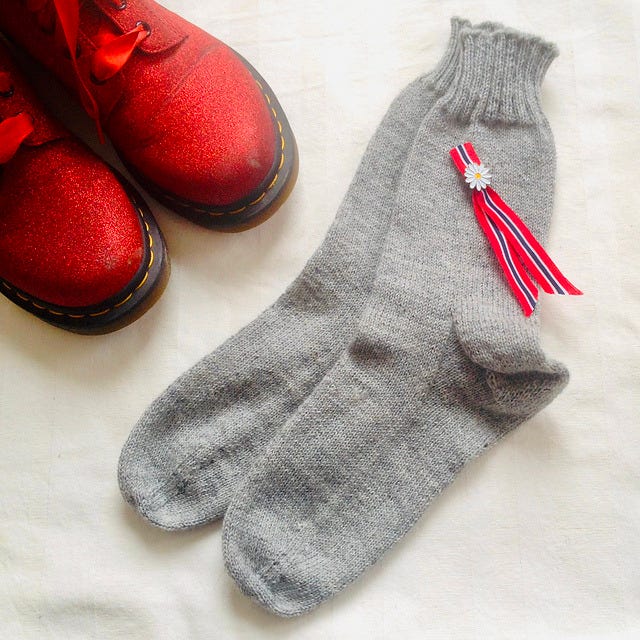Even in Norway, where knitting is a major part of the material culture, I often feel that there is little appreciation of the craft. We are well into autumn, and in a few months the country will be awash with Christmas markets where handknitted hats, mittens, and socks will be for sale at prices that barely recoup the cost of the yarn. This situation is probably the result of a combination of factors, the most obvious ones being that the sellers are all retirees who really do only want to recover the yarn costs, while customers have come to expect these ultra-low prices. The devaluing of knitting as a feminine-coded activity as well as the rise of fast fashion doubtlessly also play a part.
Curiously enough, though, people are still willing to shell out for bunad, or Norwegian traditional clothing. Handknitted stockings and accompanying handdwoven ribbons for men’s bunad from Sunnmøre can cost nearly $500. (Bunad itself cost between $2000-5000 dollars, depending on the style and whether it is made in Norway or abroad.1) Nevertheless, despite having been approached regularly over the years by people who desire to commission knitwear from me, I have yet to meet someone willing to pay $500 for a pair of socks like the ones pictured below.
$500?! That’s insane! And anyway, you’re an idiot—your labour’s only worth what someone’s willing to pay for it. So you’d better accept my $20 for those socks and be grateful for it!
Well, yes, I understand that no one wants to pay much given that these socks look pretty basic.
For all that they look simple, however, they also took at least 40 hours to make, and I reckon myself a fairly fast knitter.
Now, let’s break down the price.
There is no minimum hourly wage in Norway that applies across all sectors. Instead, wage agreements are negotiated between unions and specific industries. For example, in 2021, a cleaner’s minimum wage was 196 kr/hour, for truck drivers it was 185 kr/hour, and for seasonal agricultural workers employed for up to 24 weeks it was 134 kr/hour.2 Back in 2011 I made 175 kr/hour as a temp at a knitting company. For the purposes of this article, however, I will take the lowest minimum wage of 134 kr/hour because that’s pretty much the level at which handknitted goods are valued by the general public. Even then, things are going to get expensive.
At 134 kr/hour, and assuming that I knitted very quickly and needed only 40 hours for these socks, the labour alone will cost 5360 kr, or about US$500. However, the fact that I’m able to knit them in “only” 40 hours is due to the fact that I’ve spent nearly 40 years effectivising my knitting abilities. I’ve also knitted this particular pattern at least 10 times, which means that I’ve made 20 socks in exactly the same way. My hands and brain can knit them on autopilot. Someone with less experience with knitting in general and the pattern in particular might take substantially longer for the same project. On that note, I feel that charging 134 kr/hour devalues both my skills and my time, and that 196 kr/hour would be much more appropriate.3 In that case, get ready to shell out 7840 kr, or about $750.
It is possible to drastically reduce these prices by using another method to calculate them. Some knitters use a meterage system in which they charge per meter of yarn, varying the price per meter in accordance with the complexity of the pattern and the thickness of the yarn. I’ve seen ranges between $0.10-0.30 per meter, although it was some years ago and I’d expect an inflation-related increase. Anyway, for these socks I would charge at least $0.30 because of the thin yarn; they need about 400 meters of said yarn. Hence, the same socks that at an hourly rate cost $500 end up a fraction of the price when charged per meter—they’re a bargain at “just” $120, and $40 if you take the lower end of the scale and only charge $0.10 per meter.
Long ago I concluded that I am better off knitting gifts for the people that I love than suffering the psychological violence of having this labour constantly demeaned on the free market. I wish this weren’t the case (and, perhaps if I lived in a country with a less extravagant cost of living, it might be); but in the meantime I live in hope of an impending apocalypse, because I’ve been informed that my knitting and spinning skills will then be extremely desirable and at that point $500 handknitted socks are going to seem like a bargain.
For example, Norske Bunader outsources part of their production to China. Bunad from their workshop are approximately half the price of their equivalents from Norsk Flid, which are made wholly in Norway.
https://frifagbevegelse.no/magasinet-for-fagorganiserte/her-er-den-nye-lovfesta-minstelonna-i-ni-bransjar-6.158.799586.2d4900fae1
Since temporary agricultural workers generally come from abroad and stay only for the summer season, it’s not entirely fair to use those numbers to calculate a “yearly” salary for someone living full-time in Norway. However, let’s do so anyway: 37.5 hours/week * 52 weeks = 261 300 kr. That’s nearly 50 000 kr under the minimum set by the Norwegian government to be considered self-supporting (310 070 kr). So, even if someone worked full-time as a contract knitter at the very lowest price point, they’d still be too poor to apply for permanent residency or citizenship.



